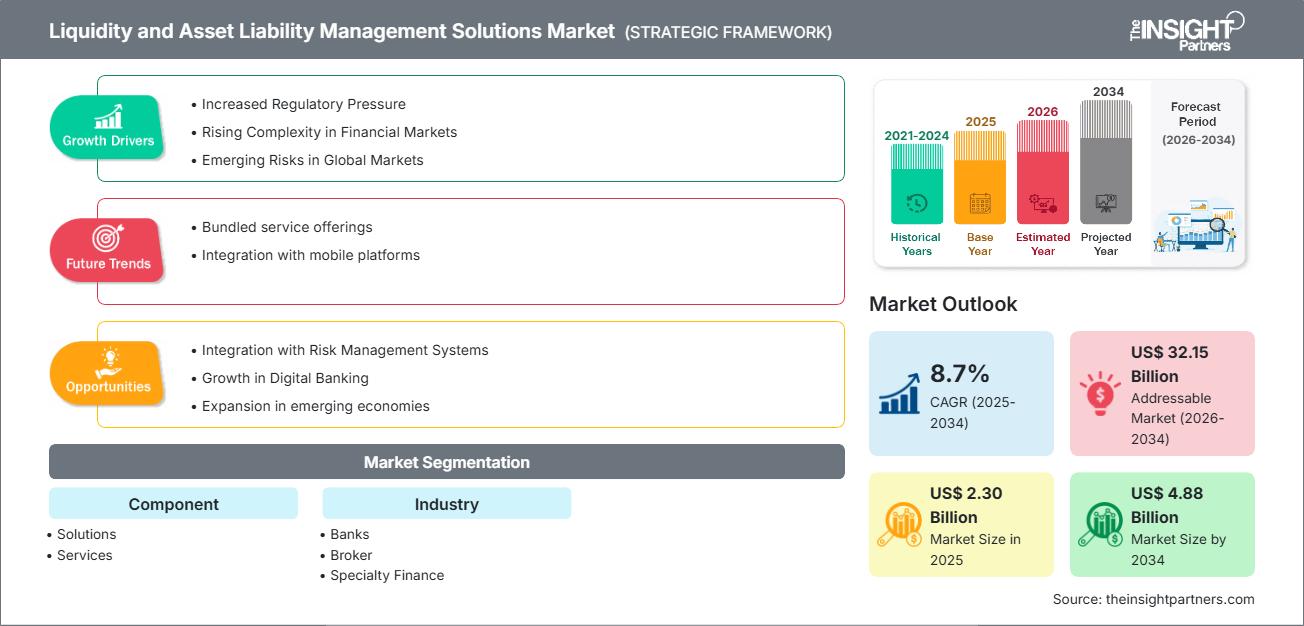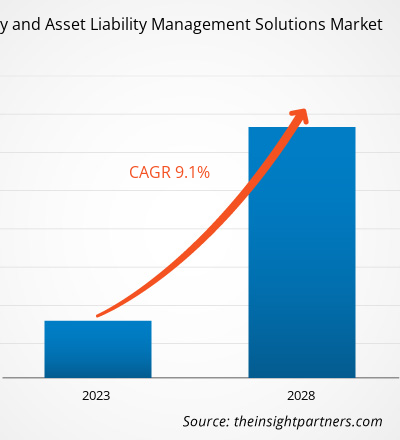流動性および資産負債管理 (ALM) ソリューション市場は、予測期間中に 8.7% の CAGR で成長し、2025 年の 23 億米ドルから 2034 年には 48 億 8,000 万米ドルに成長すると予測されています。
流動性および資産負債管理ソリューション市場分析
金融機関における信用リスクの増大と金利リスクに対する規制圧力の高まりが、流動性およびALMソリューション市場を牽引しています。銀行などの金融機関は、シナリオ分析の実行、バランスシートのより効果的な管理、そして資本および資金調達要件の強化への対応に、この種のソリューションを活用しています。高度なALMソリューションには、金融機関が事業の様々なレベルで収益性を計算できるFTPモジュールが搭載されています。
米国、英国、日本など世界的に金利の変動が拡大し、純金利マージンへの圧力が高まっているため、効果的な ALM が極めて重要になっています。
流動性および資産負債管理ソリューション市場の概要
流動性管理とは、債務を履行するために十分な現金と流動資産を確保することを指します。一方、資産負債管理(ALM)とは、資産と負債の満期、利率、および量を調整することで、リスクを最小限に抑え、収益性を最適化することです。
流動性および ALM ソリューションは、金融機関がこれらのダイナミクスを効率的にモデル化および制御するのに役立ち、リスクベースの意思決定、予測、規制遵守、パフォーマンスの最適化を可能にします。
要件に合わせてレポートをカスタマイズ
このレポートの一部、国レベルの分析、Excelデータパックなど、あらゆるレポートを無料でカスタマイズできます。また、スタートアップや大学向けのお得なオファーや割引もご利用いただけます。
流動性および資産負債管理ソリューション市場:戦略的洞察

-
このレポートの主要な市場動向を入手してください。この無料サンプルには、市場動向から見積もりや予測に至るまでのデータ分析が含まれます。
流動性および資産負債管理ソリューション市場の推進要因と機会
市場の推進要因:
- 金融機関における信用リスクの増大: 債務不履行の増加、融資ポートフォリオの逼迫、および不確実なマクロ環境により、金融機関は流動性および金利リスクを管理するためのソリューションを導入する必要に迫られています。
- 規制圧力: 銀行勘定の金利リスク (IRRBB)、資金調達計画のストレス テスト、資本リスク フレームワークなどのほとんどの規制により、銀行は精緻な ALM モデルを実行することが義務付けられています。
- 変動の激しい金利環境: 世界的な金利変動によりマージンが圧縮され、収益性を確保するために効果的な ALM の必要性が高まっています。
- デジタル化と分析: 金融機関は、データ分析、シナリオのシミュレーション、ALM の予測に基づいて意思決定を行うようになっています。
機会:
- リスク モデリングのための AI/機械学習: 高度な AI を活用した ALM ツールにより、予測、流動性ストレス テスト、シナリオ管理を改善できます。
- クラウドベースの ALM プラットフォーム: クラウドを導入すると、機関はインフラストラクチャ コストを削減しながら、ALM システムをより柔軟に拡張できるようになります。
- 財務システムとの統合: ALM ツールは、財務、リスク、資金移転価格設定システムと統合して、統一された意思決定フレームワークを作成できます。
- 新興市場での拡大: 新興経済国 (アジア太平洋地域など) の銀行が成長するにつれて、高度な流動性および ALM ソリューションに対するニーズが高まっています。
流動性および資産負債管理ソリューション市場レポートのセグメンテーション分析
コンポーネント別:
- ソリューション
- サービス
業種/機関種別:
- 銀行
- ブローカー
- 専門金融
- ウェルスアドバイザー
- その他
地理別:
- 北米
- ヨーロッパ
- アジア太平洋
- 南米と中央アメリカ
- 中東・アフリカ
流動性および資産負債管理ソリューション市場の地域別分析
流動性・資産負債管理ソリューション市場における予測期間全体にわたる地域的な動向と要因については、The Insight Partnersのアナリストが詳細に解説しています。本セクションでは、流動性・資産負債管理ソリューション市場のセグメントと地域についても、北米、欧州、アジア太平洋、中東・アフリカ、中南米に分けて解説しています。
流動性および資産負債管理ソリューション市場レポートの範囲
| レポート属性 | 詳細 |
|---|---|
| 2025年の市場規模 | 23億ドル |
| 2034年までの市場規模 | 48億8000万米ドル |
| 世界のCAGR(2025年~2034年) | 8.7% |
| 履歴データ | 2021-2024 |
| 予測期間 | 2026~2034年 |
| 対象セグメント |
コンポーネント別
|
| 対象地域と国 |
北米
|
| 市場リーダーと主要企業の概要 |
|
流動性と資産負債管理ソリューション市場のプレーヤー密度:ビジネスダイナミクスへの影響を理解する
流動性・資産負債管理ソリューション市場は、消費者嗜好の変化、技術の進歩、製品メリットへの認知度向上といった要因によるエンドユーザー需要の高まりに牽引され、急速に成長しています。需要の高まりに伴い、企業は提供内容の拡充、消費者ニーズへの対応のためのイノベーション、そして新たなトレンドの活用を進めており、これが市場の成長をさらに加速させています。

- 流動性および資産負債管理ソリューション市場のトップキープレーヤーの概要を入手
流動性および資産負債管理ソリューションの地域別市場シェア分析
- 北米: 高度な銀行インフラ、規制の高度化、統合リスク管理プラットフォームの需要により、導入が堅調に推移しています。
- 欧州: 規制上の要求と高度な金融機関が ALM の導入を推進しており、ストレス テストと金利リスクの義務付けが鍵となります。
- アジア太平洋地域:急成長が見込まれる地域です。銀行セクターの規模の拡大、デジタルトランスフォーメーション、そしてリスク意識の高まりが、ALMの需要を押し上げています。
- 南米および中米: 成長する銀行部門のリスク管理ニーズにより、ALM の新興市場が生まれています。
- 中東およびアフリカ: 金融サービスの採用拡大と規制の成熟により、ALM ソリューション プロバイダーにチャンスが生まれます。
流動性と資産負債管理ソリューション市場のプレーヤー密度:ビジネスダイナミクスへの影響を理解する
流動性およびALMソリューション市場における競争は激化しています。主要プレーヤーには、大手グローバル金融ソフトウェア企業と地域専門企業が含まれます。ベンダーは、差別化を図るために以下の取り組みを行っています。
- FTP、シナリオ分析、ストレステストを備えた統合 ALM + 流動性リスク プラットフォームを提供します。
- 分析、AI、予測モデリングを組み込んで、将来を見据えたリスクの洞察を提供します。
- クラウドベースの ALM サービスを提供し、導入コストを削減し、スケーラビリティを向上させます。
- 銀行や金融機関と提携し、現地の規制や市場のニーズに基づいて ALM システムをカスタマイズします。
流動性およびALMソリューション市場で事業を展開する主要企業:
- エクスペリアン インフォメーション ソフトウェア株式会社
- フィデリティ・ナショナル・インフォメーション・サービス社
- フィナストラ・インターナショナル・リミテッド
- IBMコーポレーション
- インフォシス株式会社
- インテリクト・デザイン・アリーナ・リミテッド
- ムーディーズ・コーポレーション
- オラクル社
- SAP SE
調査中に分析された他の企業
- FISグローバル
- SAS インスティテュート株式会社
- ファイサーブ株式会社
- アクセンチュアPLC
- KPMG LLP
- デロイト
- PwC
- EY
- プロティビティ株式会社
- アルバレス&マルサル
流動性および資産負債管理ソリューションの市場ニュースと最近の動向
- デジタル変革イニシアチブ: 金融機関は、流動性予測とリスク管理を改善するために、リアルタイム分析、クラウド ALM、AI 駆動型ツールをますます活用しています。
- 規制ストレス テストの要求: 世界的に資本および流動性規制が厳格化される中、銀行は規制ストレス テスト、銀行勘定の金利リスク (IRRBB)、資金移転価格設定をサポートする ALM システムへの投資を増やしています。
- パートナーシップと実装: たとえば、2022 年 6 月、Infosys Finacle (EdgeVerve) は銀行と協力して財務および ALM プラットフォームを実装し、統合リスク流動性システムの導入を示しました。
流動性および資産負債管理ソリューション市場レポートの対象範囲と成果物
The Insight Partners の「流動性および資産負債管理ソリューション市場規模と予測(2021~2034 年)」レポートには、次の内容が含まれています。
- すべての主要セグメントの世界、地域、国レベルの市場規模と予測
- 詳細な市場動向:推進要因、制約要因、機会
- PEST分析とSWOT分析
- 戦略的洞察:トレンド、規制の影響、競合分析
- 業界の展望:市場集中度、主要プレーヤーのヒートマップ、最近の戦略的動き
- 主要および新興のALMソリューションプロバイダーの詳細な企業プロフィール
- 過去2年間の分析、基準年、CAGRによる予測(7年間)
- PEST分析とSWOT分析
- 市場規模価値/数量 - 世界、地域、国
- 業界と競争環境
- Excel データセット
最新レポート
お客様の声
購入理由
- 情報に基づいた意思決定
- 市場動向の理解
- 競合分析
- 顧客インサイト
- 市場予測
- リスク軽減
- 戦略計画
- 投資の正当性
- 新興市場の特定
- マーケティング戦略の強化
- 業務効率の向上
- 規制動向への対応






















 無料サンプルを入手 - 流動性および資産負債管理ソリューション市場
無料サンプルを入手 - 流動性および資産負債管理ソリューション市場